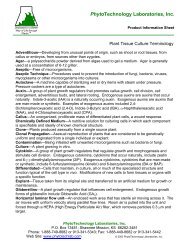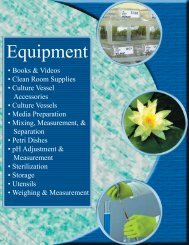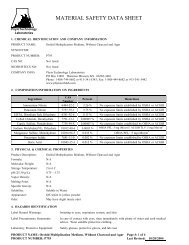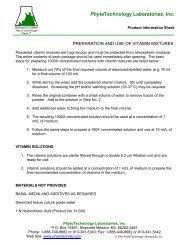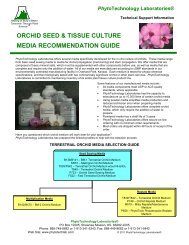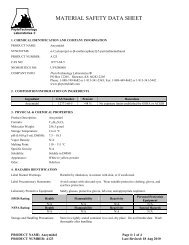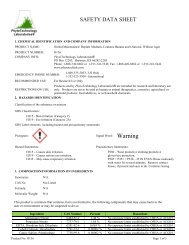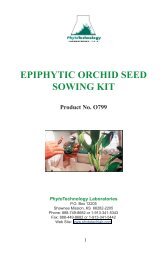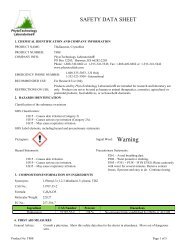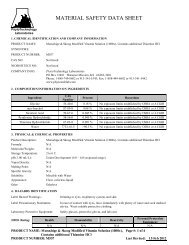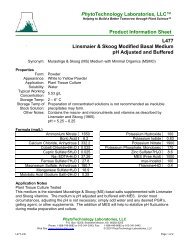Agars and Other Gelling Agents - PhytoTechnology Laboratories
Agars and Other Gelling Agents - PhytoTechnology Laboratories
Agars and Other Gelling Agents - PhytoTechnology Laboratories
You also want an ePaper? Increase the reach of your titles
YUMPU automatically turns print PDFs into web optimized ePapers that Google loves.
<strong>PhytoTechnology</strong> <strong>Laboratories</strong>®<br />
Helping to Build a Better Tomorrow through Plant Science<br />
Technical Information<br />
<strong>Agars</strong> & <strong>Other</strong> <strong>Gelling</strong> <strong>Agents</strong><br />
<strong>PhytoTechnology</strong> <strong>Laboratories</strong>® offers a variety of agars <strong>and</strong> other products that can be<br />
used as gelling agents. These products have been tested in plant tissue culture<br />
applications to ensure the highest quality.<br />
Agar is a natural product, which is<br />
produced from a family of red seaweeds<br />
(Rhodophycae) primarily from two genera,<br />
Gellidium <strong>and</strong> Gracillaria. <strong>Agars</strong> produced<br />
from Gelidium typically have higher gel<br />
strength than those from Gracilaria.<br />
Geledium is a small, slow growing plant.<br />
Efforts to cultivate it in tanks or ponds<br />
have been biologically successful;<br />
however, it has generally proved to be<br />
uneconomic.<br />
Gracilaria was once considered unsuitable<br />
for agar production because the gel<br />
strength was too low. However, in the<br />
1950’s it was discovered that pretreatment<br />
of the seaweed with alkali before extraction lowered the yield but gave an agar with higher gel<br />
strength.<br />
Agar has long been used to solidify media for plant tissue culture. The type of agar or gelling agent used<br />
can influence the growth of the tissue in culture. Both purity <strong>and</strong> cost of the gelling agent are important<br />
factors in any research or production operation. <strong>PhytoTechnology</strong> <strong>Laboratories</strong>® has exp<strong>and</strong>ed its line of<br />
gelling agents to allow greater selection in choosing the plant cell culture tested gelling agent for your<br />
particular requirement.<br />
Since agar is derived from a biological source, the properties of this product can vary from lot to lot.<br />
<strong>PhytoTechnology</strong> <strong>Laboratories</strong>® screens every lot of agar prior to accepting it for use in plant tissue<br />
culture. We evaluate each lot for clarity, gel strength, biological growth of plants along with other<br />
physiochemical properties of the product. We suggest for critical research or production criteria, you<br />
may want to screen each lot prior to purchase. <strong>PhytoTechnology</strong> <strong>Laboratories</strong>® will reserve material for<br />
your use for a period of up to six months.<br />
<strong>PhytoTechnology</strong> <strong>Laboratories</strong>®<br />
P.O. Box 12205; Shawnee Mission, KS 66282-2205<br />
Phone: 1-888-749-8682 or 1-913-341-5343; Fax: 1-888-449-8682 or 1-913-341-5442<br />
Web Site: www.phytotechlab.com<br />
© 2014 <strong>PhytoTechnology</strong> <strong>Laboratories</strong>®<br />
<strong>Gelling</strong> <strong>Agents</strong><br />
Revised Jun 2014 CC<br />
Page 1 of 4
<strong>PhytoTechnology</strong> <strong>Laboratories</strong>®<br />
Helping to Build a Better Tomorrow through Plant Science<br />
Technical Information<br />
Listed in the following table are some criteria, which may help you select the appropriate product for your<br />
application.<br />
Agar <strong>and</strong> <strong>Other</strong> <strong>Gelling</strong> <strong>Agents</strong> Selection Guide<br />
Product<br />
Number<br />
A111<br />
A296<br />
A175<br />
A133<br />
A105<br />
A110<br />
A1315<br />
A108<br />
C257<br />
C2000<br />
G434<br />
G3251<br />
Product Description<br />
Agar,<br />
Micropropagation<br />
Grade<br />
Agar, Bacteriological<br />
Grade<br />
Agar, Purified<br />
AgarGellan—A<br />
proprietary blend of<br />
agar <strong>and</strong> Gellan Gum<br />
Agarose, Low <strong>Gelling</strong><br />
Temp. (26-29° C)<br />
Agarose, Low EEO<br />
(>35° C)<br />
Agarose, Low <strong>Gelling</strong><br />
Temp.<br />
SeaPlaque®<br />
Alginic Acid<br />
Carrageenan –<br />
Gelcarin GP 812®<br />
Carrageenan, High<br />
Clarity<br />
Gellan Gum<br />
Gelzan TM –<br />
Trademarked product<br />
of CP Kelco®<br />
Use<br />
General Plant TC,<br />
Micropropagation<br />
General Plant TC,<br />
Microbiology<br />
Research<br />
High purity agar for<br />
embryogenic or<br />
other critical<br />
research<br />
General Plant TC/<br />
Micropropagation<br />
Plant TC Research<br />
Plant TC Research<br />
Plant TC Research<br />
Embryo, Cell, <strong>and</strong><br />
Protoplast<br />
Encapsulation<br />
General Plant TC/<br />
Micropropagation<br />
General Plant TC/<br />
Micropropagation<br />
General Plant TC<br />
/Micropropagation<br />
General Plant TC/<br />
Micropropagation<br />
Powder<br />
Color<br />
White to<br />
Off-White<br />
Tan<br />
White<br />
Off-White<br />
White to<br />
Off-White<br />
White to<br />
Off-White<br />
White to<br />
Off-White<br />
White to<br />
Off-White<br />
Gel Color<br />
Opaque to<br />
Off-White<br />
Tan to<br />
Straw<br />
Colored<br />
Opaque to<br />
Off-White<br />
Opaque to<br />
Off-White<br />
Opaque to<br />
Off-White<br />
Opaque to<br />
Off-White<br />
Gel<br />
Strength<br />
Recommended<br />
Concentration<br />
Minimum<br />
900 g/cm 2 5.0 to 8.0 g/L<br />
Minimum<br />
700 g/cm 2 6.0 to 12.0 g/L<br />
Minimum<br />
700 g/cm 2 8.0 to 10.0 g/L<br />
TBD<br />
3.5 to 5.0 g/L<br />
Minimum<br />
250 g/cm 2 6 to 10 g/L<br />
Minimum<br />
800 g/cm 2 6 to 10 g/L<br />
Colorless TBD 6 to 10 g/L<br />
Opaque to<br />
Off-White<br />
TBD<br />
1.75 -4.0%<br />
(w/v)<br />
Tan Tan TBD 8 to 10 g/L<br />
Tan<br />
White to<br />
Off-White<br />
White to<br />
Off-White<br />
Slight<br />
Yellow Tint<br />
Colorless<br />
Colorless<br />
Minimum<br />
800 g/cm 2 8 to 10 g/L<br />
Minimum<br />
800 g/cm 2 1.5 to 2.5 g/L<br />
Minimum<br />
400 g/cm 2 1.5 to 2.5 g/L<br />
<strong>PhytoTechnology</strong> <strong>Laboratories</strong>®<br />
P.O. Box 12205; Shawnee Mission, KS 66282-2205<br />
Phone: 1-888-749-8682 or 1-913-341-5343; Fax: 1-888-449-8682 or 1-913-341-5442<br />
Web Site: www.phytotechlab.com<br />
© 2014 <strong>PhytoTechnology</strong> <strong>Laboratories</strong>®<br />
<strong>Gelling</strong> <strong>Agents</strong><br />
Revised Jun 2014 CC<br />
Page 2 of 4
Preparation of Agar (Product No. A111, A175 <strong>and</strong> A296)<br />
<strong>PhytoTechnology</strong> <strong>Laboratories</strong>®<br />
Helping to Build a Better Tomorrow through Plant Science<br />
Technical Information<br />
Agar is by far the most common gelling agent used in plant tissue culture. It is used at a wide range of concentrations from 6<br />
g/L for a very solid gel to 10 g/L for a brick-like gel; however, 6-8 g/L is the more commonly used range. Agar should be<br />
added slowly to the media while stirring or agitating. The pH of the media should be adjusted after the inclusion of agar. This<br />
is critical for proper gelling since the pH of the agar can vary from lot to lot. The agar gel generally becomes softer the more<br />
acidic the pH of the medium. Many types of agar will not properly gel at a pH of less than approximately 5.2.<br />
Preparation of Agargellan (Product No. A133)<br />
Agargellan is a proprietary blend of micropropagation grade agar <strong>and</strong> Biotech grade CultureGel (Gellan Gum) that was<br />
developed to help control hyperhydricity in plant tissue cultures. Agargellan provides the positive attributes of both agar <strong>and</strong><br />
Gellan Gum <strong>and</strong> is superior to Gellan Gum alone in applications where hyperhydricity is a problem. It also serves as an<br />
economical alternative to agar for many species. Agargellan produces a semi-clear gel which allows for improved detection of<br />
contamination, relative to agar gels. Agargellan should be used at a concentration of 3.5 - 5.0 g/L. As with agar <strong>and</strong> Gellan<br />
Gum, is should be added to stirring medium that is room temperature.<br />
Preparation of Alginate Gel/Beads (Product No. A108)<br />
Alginic Acid has been used for a number of cell <strong>and</strong> tissue culture applications including use as a physical support similar to<br />
agarose <strong>and</strong> for the preparation of gelled beads. Both of these applications have been used to immobilize <strong>and</strong> embed<br />
suspension cells <strong>and</strong> protoplasts (Adaoha Mbanaso <strong>and</strong> Roscoe, 1982; Chee <strong>and</strong> Cantliffe, 1989; Draget et al., 1988; Larkin et<br />
al., 1988). Alginate solutions form a reversible gel at room temperature in the presence of calcium ions. The gel can be reliquified<br />
with a chelating agent, such as citrate. Cells imbedded in gel matrices can be manipulated with significantly less<br />
physical damage during h<strong>and</strong>ling than cells in liquid medium.<br />
Alginate should be dissolved in a low calcium (e.g., 2 mM) buffered medium at 1.75 - 4.0% (w/v). If protoplasts are to be<br />
embedded in the gel then the medium should contain an appropriate osmoticum. Alginic acid will require several hours to<br />
dissolve. As it dissolves, the solution will increase in viscosity. This viscosity will negate filter sterilization through a 0.2 µm<br />
membrane; a 0.45 µm membrane can be used. While some researches have indicated that alginate solutions can be autoclaved,<br />
Larkin et al. (1988) noted a reduction in bead-making capacity with increased autoclave time.<br />
If protoplasts are to be embedded, they should first be concentrated by centrifugation in a low calcium medium <strong>and</strong> added to<br />
alginate at an appropriate density (e.g., 1 x 10 5 cells/ml). The protoplast-alginate solution is added drop-wise to a solution<br />
containing 50 mM CaCl 2 <strong>and</strong> an appropriate osmoticum. Each droplet will for a bead. The beads should remain in the CaCl 2<br />
for up to 45 minutes to ensure optimum gel matrix formation.<br />
Preparation of CultureGel Gellan Gums (Product No. G434 <strong>and</strong> G3251)<br />
CultureGel Gellan Gum is an alternative gelling agent to agars. Gellan Gum is produced from a bacterial substrate composed<br />
of glucuronic acid, rhamnose, <strong>and</strong> glucose. G434 is a biotech grade that is very clear that produces high strength gel that is<br />
<strong>PhytoTechnology</strong> <strong>Laboratories</strong>®<br />
P.O. Box 12205; Shawnee Mission, KS 66282-2205<br />
Phone: 1-888-749-8682 or 1-913-341-5343; Fax: 1-888-449-8682 or 1-913-341-5442<br />
Web Site: www.phytotechlab.com<br />
© 2014 <strong>PhytoTechnology</strong> <strong>Laboratories</strong>®<br />
<strong>Gelling</strong> <strong>Agents</strong><br />
Revised Jun 2014 CC<br />
Page 3 of 4
<strong>PhytoTechnology</strong> <strong>Laboratories</strong>®<br />
Helping to Build a Better Tomorrow through Plant Science<br />
Technical Information<br />
significantly clearer than agar gels. This aids in the detection of microbial contamination. Gellan gum offers an economical<br />
alternative to agar in many in vitro applications. Gellan gum will form a gel in the presence of mono- or divalent cations; the<br />
latter being more efficient, e.g., calcium, magnesium; however, gellan gum is not recommended for use with DKW (9.3 mM<br />
Ca++) or other media e.g., Quoirin & Lepoivre Basal Salt Mixture containing high calcium levels as they have shown to<br />
produce a soft <strong>and</strong> cloudy gel.<br />
Gellan gum is typically used at a concentration from 2 to 4 g/L. It is suspended in medium that is room temperature or colder.<br />
Attempting to suspend it in hot medium will usually result in an incomplete, lumpy suspension that will not melt <strong>and</strong> dissolve<br />
uniformly when autoclaved. It should be added to medium after all heat-stable supplements have been added.<br />
Preparation of Carrageenan (Product No. C257 <strong>and</strong> C2000)<br />
Carrageenan is produced from a family of red seaweeds, Rhodophyceae, of many different genera such as Chondrus,<br />
Eucheuma, Gigartina, <strong>and</strong> Iridaea. These different genera produce different types of carrageenans such as kappa, lambda, <strong>and</strong><br />
iota. Product No. C257 is Gelcarin GP 812® which is a registered trademark of FMC BioPolymer. It is a kappa-type<br />
carrageenan that forms a strong, rigid gel in the presence of potassium ions often under the process called potassium<br />
precipitation.<br />
When carrageenan is dissolved properly, it will produce a rigid gel. Carrageenan is typically used at a wide range of<br />
concentrations from 6 g/L to 10 g/L. It is suspended in a medium that is at room temperature or colder like agar. Carrageenan<br />
should be added last since the medium will become viscous, as carrageenan is a water-soluble polymer; the viscosity of<br />
carrageenan increases with concentration <strong>and</strong> decreases with temperature. Moreover, carrageenan should also be added slowly<br />
to an agitated medium to help prevent clumping of the carrageenan <strong>and</strong> to create a uniform suspension. A lumpy suspension of<br />
carrageenan will not dissolve uniformly when autoclaved. Next, the pH of the medium should be adjusted. After autoclaving,<br />
stir the medium to distribute the melted carrageenan uniformly into the solution.<br />
<strong>PhytoTechnology</strong> <strong>Laboratories</strong>®<br />
P.O. Box 12205; Shawnee Mission, KS 66282-2205<br />
Phone: 1-888-749-8682 or 1-913-341-5343; Fax: 1-888-449-8682 or 1-913-341-5442<br />
Web Site: www.phytotechlab.com<br />
© 2014 <strong>PhytoTechnology</strong> <strong>Laboratories</strong>®<br />
<strong>Gelling</strong> <strong>Agents</strong><br />
Revised Jun 2014 CC<br />
Page 4 of 4



